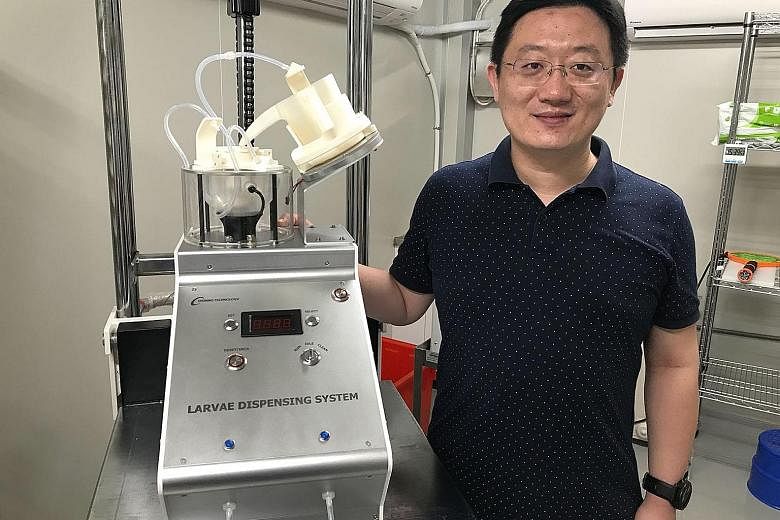As part of an ongoing field study into curbing dengue transmissions here, researchers have been breeding Aedes aegypti mosquitoes and infecting them with the Wolbachia bacteria.
The process was laborious, with researchers having to count each larva individually as they filled a tray of water with 4,000 mosquito larvae.
But in 2016, local start-up Orinno Technology created a device which reduced the two-hour process to just three minutes.
Called the larvae counter, it counts mosquito larvae 30 times faster than manual methods. This has helped to increase the production rate and quality of male Wolbachia-Aedes mosquitoes reared for research.
The field study into a novel method to suppress Aedes aegypti mosquitoes in Singapore has delivered promising results.
In the study, male Aedes aegypti mosquitoes, which neither bite humans nor transmit disease, are artificially infected with Wolbachia bacteria. When they are released and mate with females which are not infected, the resulting eggs do not hatch.
Orinno Technology created the larvae counter in collaboration with the National Environment Agency's (NEA) Environmental Health Institute. It is also developing a pupae counter and dispenser, and an automated sex sorter that can separate male and female mosquitoes.
The larvae counter has allowed researchers to produce enough male mosquitoes for the first phase of the study, said the NEA.
The results of this phase, released last year, showed that it was successful in suppressing half the targeted Aedes aegypti population observed in three sites.
The ongoing second phase will involve more housing blocks in two of the three sites previously studied.
Speaking to The Straits Times, Orinno Technology's co-founder, Dr David Du, 35, said: "The automatic tools will help to increase the number of mosquitoes reared, so they can be deployed on a large enough scale for the study."
All these devices will help to save manpower and cost, and ensure the consistency and quality of the male mosquitoes produced, said Dr Du, who has a PhD in engineering.
He said that one of the challenges in mosquito rearing was ensuring that the larvae grow in a uniform way. Male mosquito pupae are smaller than female pupae, so uniformity in size will allow the sorting process to be done more accurately.
"The larvae counter will also ensure the population number in each dish is the same."
He said the devices will benefit public health in Singapore and the world. "If this strategy is a success, it will create a lot of value, especially for people in developing countries." He added: "Besides, I always get bitten by mosquitoes, and that's one personal reason for me."
Dr Du said that after a presentation at the Asean Dengue Day Workshop here last week, representatives from countries in attendance showed interest in the devices.
"Many countries are adopting similar projects, and we are exploring possible collaboration opportunities," he added. Similar field studies have been done in China, Australia and Thailand, but Singapore is the first to adopt its tools.
The two-day conference, held in the lead-up to Asean Dengue Day last Friday, saw a total of 150 participants from 24 countries, comprising researchers, policymakers and experts in the pest control industry.
There were 2,772 dengue cases reported here for the whole of last year. During Singapore's worst dengue epidemic in 2013, more than 22,000 people were infected.


